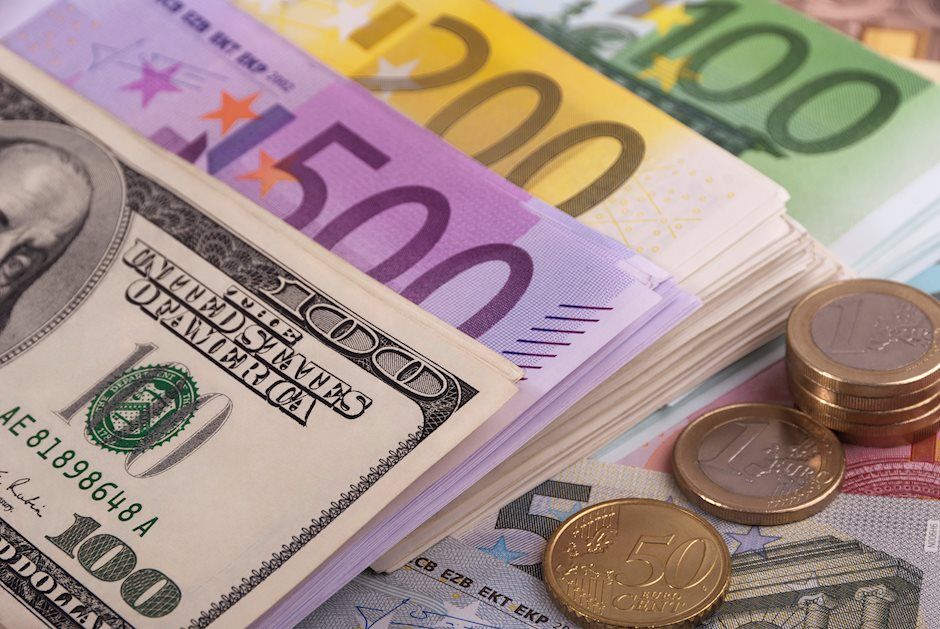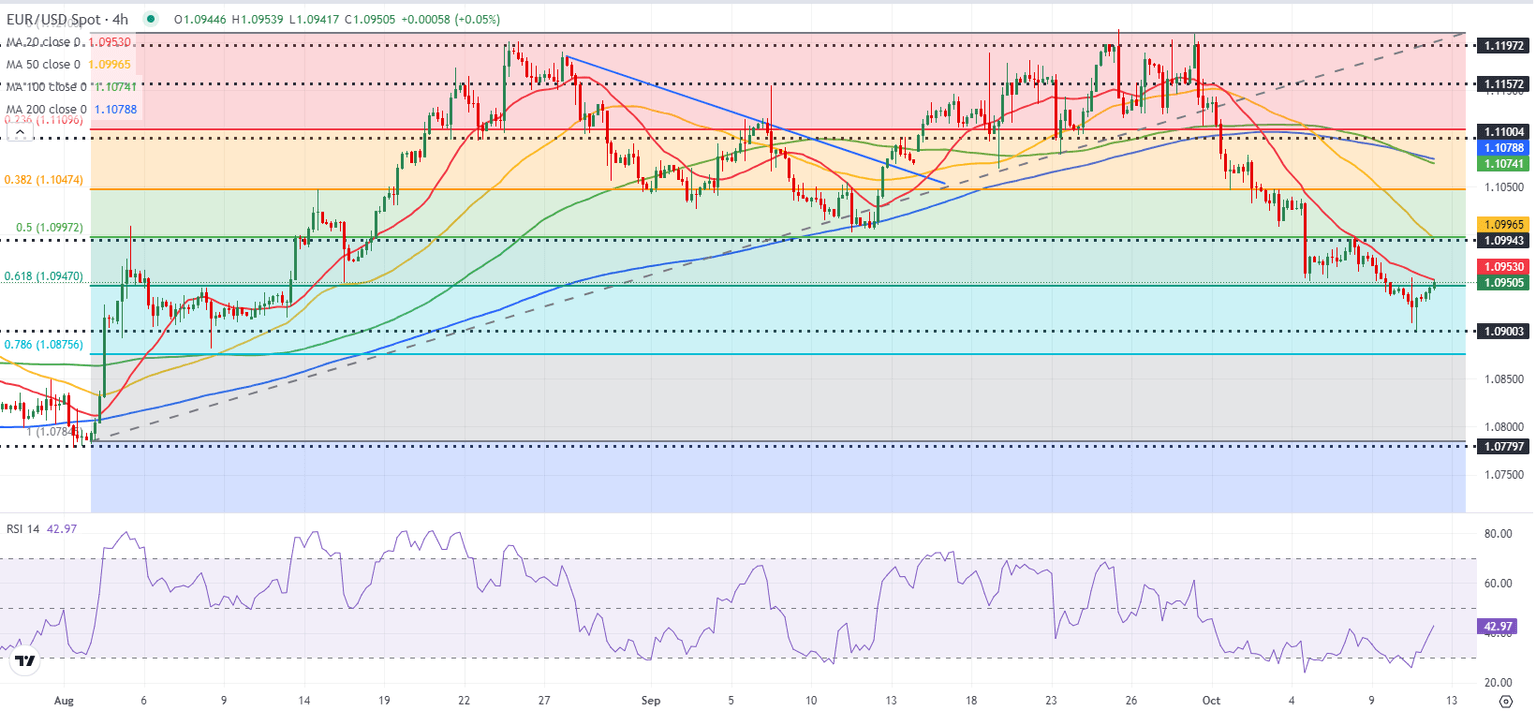EUR/USD Forecast: Euro could extend recovery once it confirms 1.0950 as support
- EUR/USD recovers modestly after testing 1.0900 on Thursday.
- The technical outlook points to a loss of bearish momentum.
- The US economic calendar will feature producer inflation data for September.

After touching its weakest level since early August at 1.0900 on Thursday, EUR/USD staged a rebound and closed the day unchanged. The pair edges higher and trades at around 1.0950 in the European session on Friday.
Euro PRICE This week
The table below shows the percentage change of Euro (EUR) against listed major currencies this week. Euro was the weakest against the Swiss Franc.
| USD | EUR | GBP | JPY | CAD | AUD | NZD | CHF | |
|---|---|---|---|---|---|---|---|---|
| USD | 0.20% | 0.32% | 0.00% | 1.43% | 0.82% | 1.01% | -0.29% | |
| EUR | -0.20% | 0.18% | -0.16% | 1.28% | 0.60% | 0.80% | -0.52% | |
| GBP | -0.32% | -0.18% | -0.37% | 1.08% | 0.42% | 0.65% | -0.58% | |
| JPY | 0.00% | 0.16% | 0.37% | 1.42% | 0.79% | 0.95% | -0.27% | |
| CAD | -1.43% | -1.28% | -1.08% | -1.42% | -0.57% | -0.42% | -1.69% | |
| AUD | -0.82% | -0.60% | -0.42% | -0.79% | 0.57% | 0.25% | -1.07% | |
| NZD | -1.01% | -0.80% | -0.65% | -0.95% | 0.42% | -0.25% | -1.25% | |
| CHF | 0.29% | 0.52% | 0.58% | 0.27% | 1.69% | 1.07% | 1.25% |
The heat map shows percentage changes of major currencies against each other. The base currency is picked from the left column, while the quote currency is picked from the top row. For example, if you pick the Euro from the left column and move along the horizontal line to the US Dollar, the percentage change displayed in the box will represent EUR (base)/USD (quote).
The initial reaction to September inflation data from the US caused EUR/USD to push lower in the early American trading hours on Thursday. The disappointing labor market data, however, made it difficult for the US Dollar (USD) to preserve its strength, paving the way for a recovery in the pair.
The US Bureau of Labor Statistics announced on Thursday that inflation in the US, as measured by the change in the Consumer Price Index (CPI), declined to 2.4% on a yearly basis in September from 2.5% in August. The core CPI, which excludes volatile food and energy prices, rose 3.3% on a yearly basis, coming in above the August reading and the market forecast of 3.2%. Finally, the monthly core CPI increased 0.3%. On a negative note, weekly Initial Jobless Claims rose to 258,000 in the week ending October 5 from 225,000 in the previous week.
Later in the day, the Producer Price Index (PPI) data will be featured in the US economic calendar. Investors expect the monthly core PPI to rise 0.2% in September, following the 0.3% increase recorded in August. In case the monthly core PPI comes in above the market expectation, the USD could hold its ground heading into the weekend and cap EUR/USD's upside.
EUR/USD Technical Analysis
The Relative Strength Index (RSI) indicator on the 4-hour chart rose above 40 early Friday, reflecting a loss of bearish momentum. 1.0950 (20-period Simple Moving Average (SMA), Fibonacci 61.8% retracement of the latest uptrend) aligns as a pivot level for EUR/USD. Once this level is confirmed as support, 1.1000 (Fibonacci 50% retracement) and 1.1050 (Fibonacci 38.2% retracement) could be seen as next resistance levels.
If 1.0950 continues to hold as resistance, supports could be spotted at 1.0900 (round level), 1.0870 (Fibonacci 78.6% retracement) and 1.0800 (round level).
Euro FAQs
The Euro is the currency for the 19 European Union countries that belong to the Eurozone. It is the second most heavily traded currency in the world behind the US Dollar. In 2022, it accounted for 31% of all foreign exchange transactions, with an average daily turnover of over $2.2 trillion a day. EUR/USD is the most heavily traded currency pair in the world, accounting for an estimated 30% off all transactions, followed by EUR/JPY (4%), EUR/GBP (3%) and EUR/AUD (2%).
The European Central Bank (ECB) in Frankfurt, Germany, is the reserve bank for the Eurozone. The ECB sets interest rates and manages monetary policy. The ECB’s primary mandate is to maintain price stability, which means either controlling inflation or stimulating growth. Its primary tool is the raising or lowering of interest rates. Relatively high interest rates – or the expectation of higher rates – will usually benefit the Euro and vice versa. The ECB Governing Council makes monetary policy decisions at meetings held eight times a year. Decisions are made by heads of the Eurozone national banks and six permanent members, including the President of the ECB, Christine Lagarde.
Eurozone inflation data, measured by the Harmonized Index of Consumer Prices (HICP), is an important econometric for the Euro. If inflation rises more than expected, especially if above the ECB’s 2% target, it obliges the ECB to raise interest rates to bring it back under control. Relatively high interest rates compared to its counterparts will usually benefit the Euro, as it makes the region more attractive as a place for global investors to park their money.
Data releases gauge the health of the economy and can impact on the Euro. Indicators such as GDP, Manufacturing and Services PMIs, employment, and consumer sentiment surveys can all influence the direction of the single currency. A strong economy is good for the Euro. Not only does it attract more foreign investment but it may encourage the ECB to put up interest rates, which will directly strengthen the Euro. Otherwise, if economic data is weak, the Euro is likely to fall. Economic data for the four largest economies in the euro area (Germany, France, Italy and Spain) are especially significant, as they account for 75% of the Eurozone’s economy.
Another significant data release for the Euro is the Trade Balance. This indicator measures the difference between what a country earns from its exports and what it spends on imports over a given period. If a country produces highly sought after exports then its currency will gain in value purely from the extra demand created from foreign buyers seeking to purchase these goods. Therefore, a positive net Trade Balance strengthens a currency and vice versa for a negative balance.
Premium
You have reached your limit of 3 free articles for this month.
Start your subscription and get access to all our original articles.
Author

Eren Sengezer
FXStreet
As an economist at heart, Eren Sengezer specializes in the assessment of the short-term and long-term impacts of macroeconomic data, central bank policies and political developments on financial assets.


















